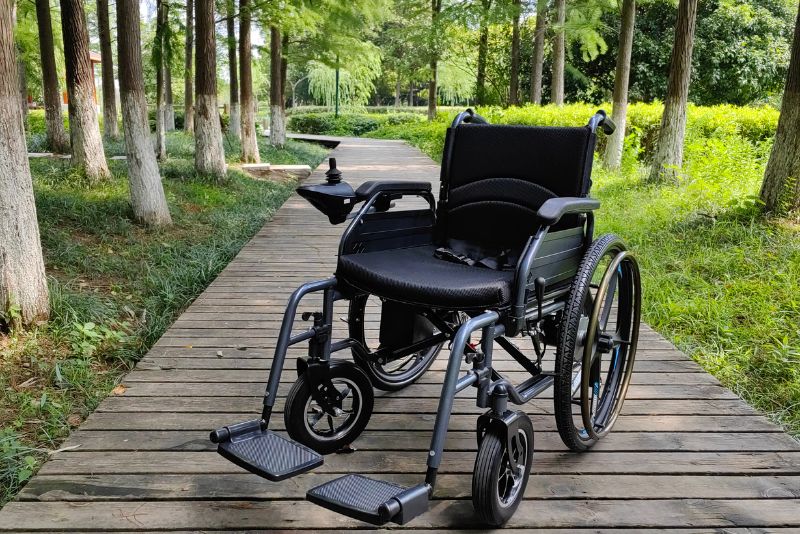Welcome to the world of mobility aids! There are many options to choose from, but don’t worry, I’m here to help. There are two types of wheelchairs: transport and standard. Transport chairs are lighter, easy to fold, and great for short trips or crowded spaces. Standard wheelchairs are better for everyday use and can be customized to fit your needs.
Choosing the right mobility aid can make a big difference in your life, and I’m excited to help you. Let’s look at the differences between transport and standard chairs, and together, we’ll find the perfect one for you.
Key Takeaways
- Transport wheelchairs are light, easy to fold, and designed for short trips with someone pushing. Standard wheelchairs have big back wheels for self-moving and daily use.
- Transport chairs fit through small spaces easily, while standard wheelchairs are heavier and wider but offer more independence.
- Both types of wheelchairs can come with safety features like brakes. Certified products ensure reliability and build quality.
- Standard wheelchairs allow customization with comfortable seats and accessories; transport chairs do not usually have these options.
What Is a Transport Chair?

Transport chair is a convenient mobility device that can help you navigate narrow corridors or visit the doctor’s office with ease. Unlike a bulkier wheelchair, this streamlined mover is designed to help you move quickly and smoothly from one place to another with the help of a friend or family member steering it.
Similarities with standard wheelchair
Both transport chairs and standard wheelchairs have seats with backrests where users can sit cozily. They come with wheels, making moving around easy for everyone. Caregivers or friends can push both types of mobility devices, so they’re helpful for those who need an extra hand.
Transport chairs and manual wheelchairs boost freedom for people who use them and their helpers. These chairs are designed to support the body well and help lessen pain for those with trouble walking.
The design aims to give users added comfort and convenience every day.
Differences in design and features
Transport chairs have smaller wheels compared to standard wheelchairs. This makes them more compact and easier to navigate in tight spaces. The front and back wheels are rather close in size, often with the front being just a bit smaller.
These chairs are built narrow, so they fit through slim doorways and aisles easily.
Standard wheelchairs feature large back wheels equipped with hand rims for self-propulsion. A user can move independently without help from others. They also have small front casters that provide stability and easy turning.
Standard models meet ADA requirements for accessibility and often come with customizable options for long-term use by wheelchair users.
Use case scenarios
Transport chairs shine in certain situations. They’re perfect when a caregiver needs to move someone who can’t walk alone.
- At the airport, they make it easy to get through long lines and crowded spaces.
- Doctor’s visits become less stressful when moving from the car to the office.
- Family outings are more enjoyable when everyone can move around easily.
- Shopping trips work better as these chairs fit well between store aisles.
- For quick trips outside, such as going to a nearby park, they’re great for short distances.
- Daily routines at home become easier with larger wheels for self-propelling.
- Going to work or school is more practical because users navigate by themselves.
- Engaging in sports or outdoor activities is possible due to their sturdiness and autonomy.
- Long walks or even marathon participation is achievable with the right wheelchair.
- With electric wheelchairs, travel over uneven terrain like grass or gravel isn’t a problem.
What Is a Standard Wheelchair?

Moving beyond the transport chair, let’s explore the world of standard wheelchairs – dependable options that are designed for long-term use and offer greater independence. These chairs are more than just a mode of transportation; they provide a pathway to mobility freedom and are specifically crafted for individuals with enduring or permanent mobility limitations.
Differences in weight and size
Standard wheelchairs are heavier, with a weight range of 30 to 80 pounds. This makes them more stable but also harder to lift and carry. The big wheels add to the weight but allow the user to move independently.
Transport chairs, on the other hand, are lighter because they’re often made of aluminum and weigh around just 20 pounds. Their size is smaller too, making them easy to fold and put in a car or closet.
Transport wheelchairs have little wheels that make them compact for tight spaces. Since they can’t be self-propelled, someone has to push them using handlebars at the back. Standard chairs offer more freedom with their large 18″-24″ wheels users can push on their own – a trade-off between independence and being lightweight enough for travel or short-term use.
Purpose and use
A standard wheelchair supports people who can move themselves using arm strength. These chairs are good for both inside and outside activities. They handle more weight, making them strong and stable for daily use.
You can rely on a standard wheelchair for long-term support because it’s made to last.
Transport wheelchairs have small wheels, so someone else must push them. This type of chair is perfect for quick trips or moving around in tight spaces. It’s not meant for someone to use by themselves but rather with help from a friend or caregiver.
Transport chairs work best when you don’t need to go far or if you’ll be getting in and out of cars often.
Key Differences Between Transport and Standard Wheelchairs
Understanding the differences between transport chairs and standard wheelchairs can open up a whole new world of mobility, independence, and convenience for those who use them on a daily basis. In this discussion, we will explore the unique features of each type of wheelchair and how they cater to diverse needs. Let’s dive in!
Wheel sizes and propulsion
Transport chairs are designed with four small wheels, which makes them different from standard wheelchairs. The smaller wheels mean someone else has to push the chair. A person can’t move it alone.
Standard wheelchairs have two large wheels in the back and two small ones in the front. This design lets the person in the chair use their hands to turn big rear wheels with hand rims.
They can go where they want without help.
In a transport wheelchair, all four wheels are about the same size, though sometimes front ones are a bit smaller. Without large rear wheels or hand rims, you can’t roll yourself around in these chairs.
People like them because they are light and easy to fold for cars or storage spaces. But if you want to be able to move on your own, choose a standard wheelchair with larger back wheels that let you control where and when you move.
Weight and width
Transport chairs are lighter and easier to move around than standard wheelchairs. They typically weigh less because they have smaller wheels and slimmer frames. The width of a transport chair is also narrower, which makes it handy for getting through tight spaces like narrow doorways or crowded places.
Standard wheelchairs are heavier due to their larger wheels, usually measuring between 18 to 24 inches. These bigger wheels add weight but give the user the ability to self-propel.
A standard wheelchair’s wider seat can handle more weight, making it sturdier and more stable for daily use.
Comfort and accessories
Standard wheelchairs come packed with options for adding comfort and personal touches. You can pick from cushiony seats, handy cup holders, and storage pouches to keep your things close.
Tray tables make eating and reading easier, while oxygen tank attachments help those who need them breathe easy. Transport chairs usually have fewer add-ons because they’re meant for quick trips.
Choosing the right chair means looking at how comfy it is and what extras you can get. If resting well or having your favorite drink by your side matters to you, a standard wheelchair might be the way to go.
These chairs are ready to morph into cozy spots that fit your life – whether that’s keeping a book handy or making sure there’s space for medical needs.
Brakes and safety features
Transport wheelchairs are made with brakes that help when getting in or out of the chair. A caregiver can use these to make sure the wheelchair stays put. This keeps you safe while you move around.
Rollators have similar features for stability and control.
Standard wheelchairs also come with important safety parts like brakes. These are found on the big wheels at the back. You or your helper can easily reach them to stop or slow down as needed.
Both kinds of wheel chairs focus on keeping you secure, whether it’s you or someone else guiding the chair.
Final Thoughts and Recommendations
Choosing the right mobility aid is a big decision. Let’s hear from an expert, meet Dr. Susan Shields. She earned her degree in Rehabilitation Science and has worked for over 20 years helping people find their perfect mobility match.
With many published papers on adaptive equipment, Dr. Shields knows wheelchairs inside out.
Dr. Shields says transport chairs are great for short trips because they’re light and easy to carry around. They fit into car trunks nicely and are simple for caregivers to use while walking with someone who needs help getting around.
When it comes to safety, Dr. Shields insists on buying certified products that meet all regulations. That way you know you’re getting something reliable and transparent about its build quality.
For those thinking of using one daily, she suggests considering how each chair will fit into your lifestyle or home setting — think door widths and ramp access if needed.
As per Dr. Shields’ balanced view, transport chairs excel in convenience but don’t offer as much independence as standard wheelchairs do—they also might not be as comfortable for long-term sitting.
In conclusion, Dr. Susan Shields believes both types have value depending on what the user needs most—transport chairs for occasional use or fitting into smaller spaces, or standard wheelchairs if self-propulsion and durability take priority.
FAQs
1. What makes a transport wheelchair different from a standard wheelchair?
A transport wheelchair is lighter and has smaller wheels, making it easier to move around in tight spaces.
2. Does a standard wheelchair weigh more than a transport wheelchair?
Yes, standard wheelchairs are typically heavier than transport wheelchairs.
3. Are the armrests and footrests on both types of chairs adjustable?
Transport wheelchairs usually have fixed armrests and footrests, while many standard wheelchairs offer adjustable ones.
4. Which type of wheelchair is best for long-term use?
Standard wheelchairs are generally better suited for long-term use due to their durability and comfort features.









